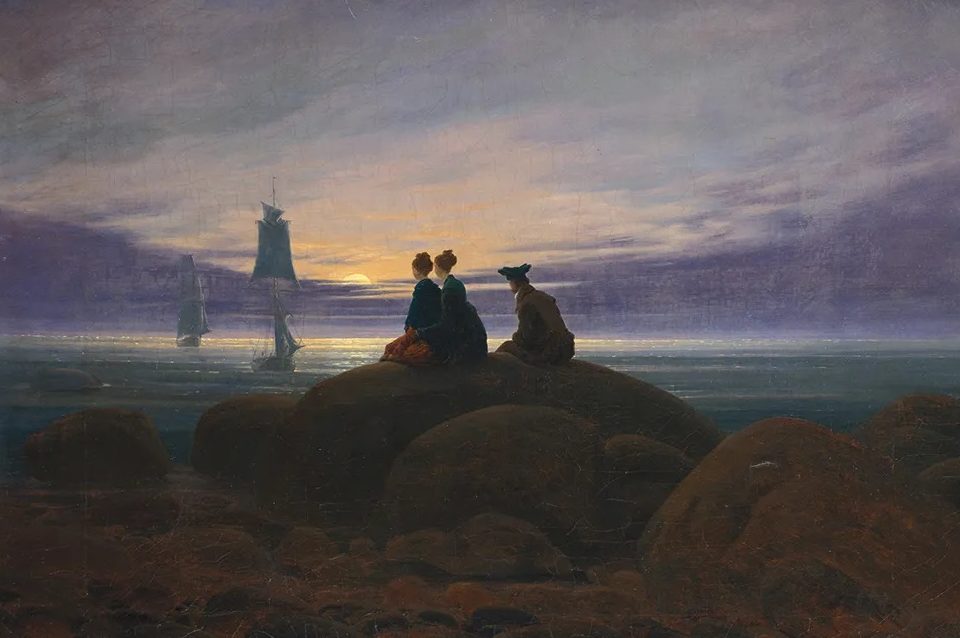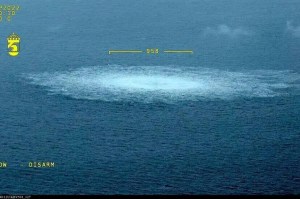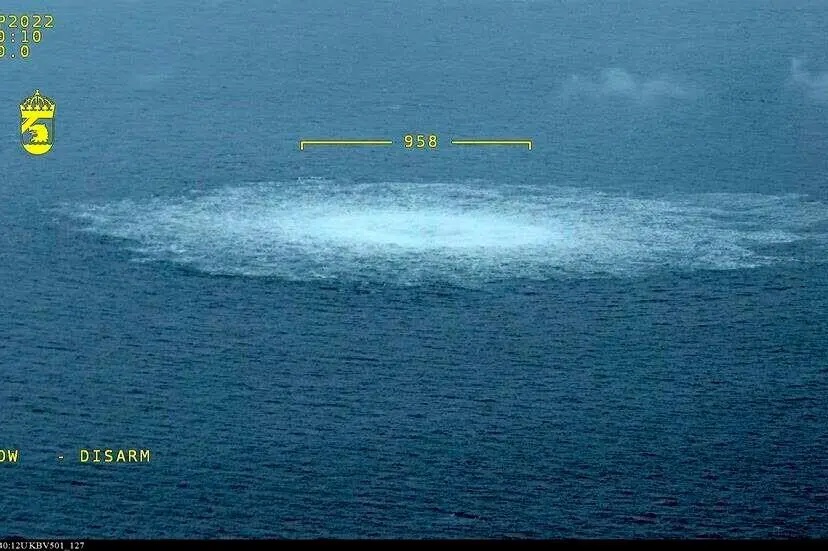Imagine wandering through Germany. You might picture blustery Baltic seascapes, seen from island retreats such as Rügen. Or you might be hiking in the central Harz mountains, peering down at clouds that drift into green pastures and blend into brownish rock. Perhaps you’re standing at the country’s eastern edge, gazing at moonlight that gleams through gaps in the forests and ravines of sandstone highlands.
What we sketch in our minds probably follows the contours of the canvases of Caspar David Friedrich, Germany’s Romantic artist-in-chief. And these stock images have been reproduced in many a tourist guide. They’re now on display again, in full color and new frames — literally and figuratively — to mark 250 years since Friedrich came into the world. We’re well into the drawn-out celebrations: the last of the year’s three major exhibitions, in Dresden, is underway and runs until January. Art for a New Age, meanwhile, is the print catalogue that memorializes the opening Hamburg show. But the book stands out on its own terms, its 400 illustrations accompanied by thick contextual detail and eleven masterly essays.
Its overarching theme is the climate crisis. “The Wanderer above the Sea of Fog” (c.1817) is the primal man, and internet meme, of the Anthropocene. Although the environment sounds too predictable a hook for hanging landscape paintings, the editors offer a thoughtful rationale that emerges from the pictures themselves. Friedrich’s scenes may appear to depict nature unbound and untouched, but they’re also famous for their Rückenfiguren in the foreground: the men and women who stand with their backs to the viewer, facing what we also see. Johannes Grave stresses that these works are really about the relationships between humans and the natural world. Markus Bertsch emphasizes the paradox that Friedrich’s aesthetic immersion in landscape is enabled by distance — spatially and subjectively. A Romantic perspective on nature is actually an uneasy one.
Friedrich’s wanderer stands back, but appears in the middle of the canvas. Compare the painting to the inspirational landscapes by the Dutch master Jacob van Ruisdael, which are peopled by figures less concerned by, and less central to, their surroundings. (Indeed, some were probably added later.) The fact that the Romantic poet Johann von Goethe saw them as more significant speaks to an experience of nature that was typical of the era: as somehow self-reflexive. When Friedrich’s “The Monk by the Sea” went on display in 1810 (and was bought by King Wilhelm III), Heinrich von Kleist was drawn to the Capuchin brother, and disturbed by the painting as a representation of nature — rather than the immense bleakness of the shoreline itself.
Friedrich is so compelling because his art works on two levels. There is an undeniable immediacy of nature that, ironically, is also obviously mediated for all to see. Or, as this book’s section of notes and illustrations devoted to the Rückenfiguren phrases it, here we are “observing nature observed.” Throughout, contributors refer to Friedrich’s characteristic ambiguity, which they read in relation to the literature and thought of the German Romantics. But they avoid the term irony, which was the watchword for authors and philosophers around 1800.
Perhaps highlighting irony would have risked encouraging more satirical reenactment shots taken up on a hill, with the back to camera, facing into the mist. (And how much of that viral kitsch has there been this year?) But beyond the scholarly field, Friedrich remains misunderstood, anyway — and, by and large, he is viewed unambiguously. The Financial Times sought to inspire readers with a romantic vision of sacred landscape that, in Friedrich’s day, was apparently not yet spoiled by tourism, even though, historically speaking, the scenes were set by industrialization cranking into gear. Getting outdoors became a popular Romantic pastime, with market potential; the railways and package tours just followed the course already laid out around 1800. Part of the problem is that Friedrich, as Grave points out, didn’t depict a changing environment and society explicitly. His figures appear as individuals: although they may bear some markings of middle-class urban holidaymakers, they can feel timeless, too. They are not representative types. And so we easily reduce the aesthetic effect of Friedrich’s paintings to their natural content, overlooking the subtle inconsistencies of their overall perspective.
The New Statesman laid it on thick and called Friedrich kitsch. A good old German word, but more applicable to Friedrich’s followers. Carl Gustav Carus’s “Goethe Monument” (1832), included in Art for a New Age, portrays conifers, rocks and the poet’s tomb, which takes center stage, shrouded in mist. Gone are Friedrichesque contradictions, uncertainties and silent debts. Ambivalence is also absent in the latest artistic responses. The first shot in Swaantje Güntzel’s series of photographs, documenting her intervention “Arctic Yogurt” (2021), is arresting and unnerving. Standing with her back to the viewer in striking red, before whitish gray Norwegian fjord, she holds an empty yogurt pot in her hand, as if she is about to drop it. Is this figure immersed and unaware, awed by nature alongside her, complicit in consumer society? Or is she casually disinterested, and potentially destructively so, because of comfortable alienation? The subsequent stills become troublingly clear. Güntzel throws the trash into the water, revealing a careless attitude that arises from Romantic contemplation. On a practical level, we should read the writing on the wall. But conceptually, this work is surely a ready-made of artistic environmentalism.
Such simple criticism reinforces a sticky, reductive interpretation of Romanticism — in a rather polluting dialectic. Mari Eastman’s painting from 2001 is another classic, mockingly portraying a “very Caspar Friedrich David mood.” (It’s misnamed with laconic purpose.)
Together, the works in the second half of Art for a New Age tend to lack a sense of their own ironies. By contrast, as the first, historical half of the book shows, the Romantics wrestled with the very paradoxes that produced their paintings and writings. Friedrich’s art was created for a commercial market, and he visited the emergent tourist hotspots of Rügen, the Harz and the eastern valleys of the Elbe for inspiration. He sought to transcend that context, without wholly negating or celebrating it. Representing the absolute was anything but.
Recent artists and critics may see a fatal flaw in an ironic attitude: it’s not committed enough to frame our own earnest times. But irony is the hidden driver of the culture industry’s “Casper David Friedrich 250” campaign, as it trundles on through the German landscape to the end of the year. I’m reminded of Friedrich’s contemporary, the poet Heinrich Heine, who went walking in the Harz in autumn 1824. With his back to Göttingen, facing the mountains, he stood in wonder, wrote heartfelt verse, and joined in the polite conversation and pseudo-profundity that he heard around him. The Romantic wanderer, the kitschy cultural tourist and those of us looking for critical takeaway certainties share the same trail. We undercut and reinforce each other to co-exist. And we all emerge from a modern, mediated relationship with the environment, which in turn we ironize, repress and oppose. That irony is what’s most eerie about both German Romanticism, and this fine catalogue.
This article was originally published in The Spectator’s UK magazine. Subscribe to the World edition here.

























